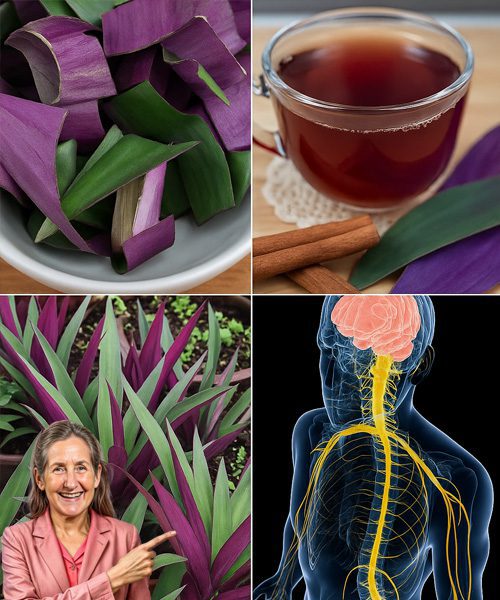Have you ever been captivated by the striking purple foliage of Tradescantia pallida, wondering if its beauty holds more than aesthetic charm? At 01:54 PM on Tuesday, June 24, 2025, let’s explore the enchanting world of this tender evergreen perennial, native to northeast Mexico. Commonly known as purple heart or purple queen, this plant from the Commelinaceae family has earned a reputation beyond its ornamental appeal, offering potential health benefits and practical uses rooted in tradition. Could this vivid plant be a hidden ally for wellness and sustainability? Join us to uncover its 15 amazing benefits and discover how to integrate it into your life.

🌸 A Rich Heritage
Tradescantia pallida was first collected in 1907 in Tamaulipas, Mexico, by botanist Edward Palmer, initially classified as Setcreasea pallida by Joseph Nelson Rose in 1911. Later reclassified by D.R. Hunt in 1975, its name “pallida” (meaning “pale”) reflects its original gray-green-purplish hue, though the cultivated ‘Purpurea’ variety shines with deep purple leaves. Traditionally, it has been used in Mexican and Southeast Asian cultures for medicinal purposes, while its air-purifying qualities have made it a modern favorite. As the afternoon sun graces June 24, 2025, its vibrant legacy invites us to delve deeper.
🌱 15 Amazing Benefits of Tradescantia pallida
- Air Purifier
Removes volatile organic compounds (VOCs) like formaldehyde and benzene, improving indoor air quality. - Anti-Inflammatory Support
Traditionally believed to reduce inflammation, potentially easing joint pain or swelling. - Antioxidant Boost
Contains anthocyanins, which combat oxidative stress and protect cells. - Improved Circulation
Folk remedies suggest it may enhance blood flow, reducing cold extremities. - Antitoxic Properties
Thought to help detoxify the body, supporting liver function in traditional use. - Stress Reducer
Its presence as a houseplant may lower stress and elevate mood, per studies on indoor plants. - Eye Pain Relief
The Ayta people of Porac, Philippines, have used it to soothe sore eyes, though evidence is anecdotal. - Skin Soother
Applied topically, it may calm irritations or rashes due to its anti-inflammatory effects. - Low-Maintenance Health Ally
Easy to grow, it offers wellness benefits with minimal care, suiting busy lifestyles. - Pollinator Attractant
Its small pink or purple flowers draw bees and butterflies, boosting garden ecosystems. - Erosion Control
Its trailing habit stabilizes soil on slopes or in poor-quality areas. - Natural Insect Repellent
Contains chemicals that may deter mosquitoes and ticks, enhancing outdoor spaces. - Food Colorant Potential
Anthocyanins provide stable, vibrant hues for natural food coloring, though legal use is limited. - Mental Well-Being
Its striking color and growth inspire creativity and emotional balance. - Phytoremediation Aid
Absorbs heavy metals and pollutants, aiding environmental cleanup efforts.
🌿 How Tradescantia pallida Works Its Magic
The plant’s benefits stem from its anthocyanin-rich leaves, which offer antioxidant and anti-inflammatory properties, and its ability to filter air pollutants. Traditional uses, such as teas for circulation or poultices for skin, leverage these compounds, though scientific validation remains limited. Its ecological roles, like soil stabilization and pollution absorption, further enhance its value.
🌳 Practical Ways to Use Tradescantia pallida
Ready to tap into this purple powerhouse? Grow it in pots or gardens, ensuring it’s from a clean source. Here’s how:
- Indoor Air Purifier: Place in bright, indirect light to enhance air quality—ideal near windows.
- Tea (Traditional): Steep 1-2 teaspoons of dried leaves in hot water for 10 minutes (use cautiously, consulting a professional due to limited safety data).
- Poultice: Crush fresh leaves, mix with water, and apply to skin for irritations (test for allergies first).
- Garden Cover: Plant as ground cover or in hanging baskets for erosion control and beauty.
- Decorative Accent: Use in containers with contrasting plants like golden creeping Jenny for visual appeal.
Propagate easily with stem cuttings in water or soil. Start small, especially with medicinal use, and monitor for skin sensitivity.
🌸 A Word of Caution
Tradescantia pallida’s sap may cause skin redness or irritation in some people and pets—handle with gloves and avoid ingestion, which can lead to mouth or stomach upset. Pregnant or breastfeeding individuals should avoid it due to insufficient safety data. Consult a healthcare provider before medicinal use, as its effects are not fully studied.
🌱 Why It Captivates
What makes Tradescantia pallida so alluring? It’s the joy of blending vibrant decor with potential health benefits, rooted in cultural traditions. Growing it or experimenting with its uses fosters a connection to nature, while its low-maintenance nature and ecological perks keep you engaged.
🌿 Embrace the Purple Journey
At 01:54 PM on June 24, 2025, let Tradescantia pallida inspire your afternoon. This purple powerhouse isn’t just a plant—it’s a pathway to cleaner air, potential wellness, and garden vitality. Will you grow it indoors, brew a tea, or use it in your landscape? The choice is yours, and the benefits await. Step into the world of Tradescantia pallida and unlock nature’s vibrant treasure!








